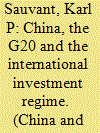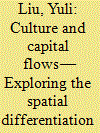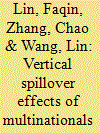|
|
|
Sort Order |
|
|
|
Items / Page
|
|
|
|
|
|
|
| Srl | Item |
| 1 |
ID:
073332


|
|
|
|
|
| Publication |
2006.
|
| Summary/Abstract |
Multinational enterprises (MNEs) from ASEAN have been internationalizing, and the dynamics of this process are of interest in the empirical literature of international business. The international organizational aspects of 135 ASEAN MNEs are examined, using Linear Structural Relations (LISREL, a statistical software package), to model their strategic coherence, dispersed functionality and international management capability. The key results are that the proposed LISREL model confirms that the predicted relationships exhibit high goodness-of-fit indices. Dispersed functionality significantly predicts strategic coherence. Dispersed functionality and international management capability display a nonrecursive, or interdependent, correlation.
|
|
|
|
|
|
|
|
|
|
|
|
|
|
|
|
| 2 |
ID:
146698


|
|
|
|
|
| Summary/Abstract |
China has become a major home country for outward foreign direct investment (OFDI) flows. As a result, the country is increasingly concerned with protecting its OFDI and facilitating the operations of its firms investing abroad and creating a strong universal international investment law and policy regime. This article briefly reviews the emergence of China as an outward investor. It continues with an analysis of some policy issues related to the rise of FDI from emerging markets. A brief discussion of issues central to the future of the international investment law and policy regime follows, before focusing on several outcomes that could be pursued under China's G20 leadership: nonbinding shared principles that could outline the architecture of a universal framework on international investment; an international support program for sustainable investment facilitation; and the creation of an additional intergovernmental platform that would allow for a continued systematic intergovernmental process to discuss the range of issues related to the governance of international investment, preferably paralleled by an informal, inclusive and result-oriented consensus-building process that takes place outside intergovernmental settings.
|
|
|
|
|
|
|
|
|
|
|
|
|
|
|
|
| 3 |
ID:
161805


|
|
|
|
|
| Summary/Abstract |
Using a panel data of China's OFDI over the period of 2003–2013, this study investigates how cultural distance and its dimensions explain China's OFDI spatial differentiation. We find that cultural distance has a curvilinear (U-shaped) relationship with China's OFDI. The growth rates of “liability of foreignness (LOF)” and “advantages of foreignness” (AOF) finally determine whether cultural distance cause conflicts or improve innovation. In addition, we find that how China's OFDI activities are related to the difference of cultural distance hinges on the particular cultural dimension in question. The latter suggests that that the relative weight of cultural dimensions should be considered in the calculation of cultural distance. Overall, this study makes important contributions to both theory and practice. Our findings offer important insights into OFDI activities and provide guidelines for managers about entry strategies.
|
|
|
|
|
|
|
|
|
|
|
|
|
|
|
|
| 4 |
ID:
075230


|
|
|
|
|
| Publication |
2006.
|
| Summary/Abstract |
What is new about globalisation? The growth of international marketing is looked at, and then Manek Kirpalani and Mika Gabrielsson turn to the main subject. The empire-building strategy of Ancient Rome, in comparison to the ongoing hegemony-building approach of the US highlights what multinational enterprises (MNE) should be doing to dominate markets. Such strategies emphasise the importance of global integration of worldwide activities and necessary market adaptations, but more importantly they introduce a third vector-control through size and power-that emerges as a requisite for successful global leadership.
|
|
|
|
|
|
|
|
|
|
|
|
|
|
|
|
| 5 |
ID:
106013


|
|
|
|
|
| Publication |
2011.
|
| Summary/Abstract |
For some 20 years, the rate of investment by EU enterprises into China has been rising, reaching an annual average of some US$5bn over the 10 years to 2009. Conversely, the EU has not been a focus for Chinese investments, nor has Chinese investment been important to the EU despite the wide attention given to recent landmark cross-border acquisitions. Therefore, the overall impact of Chinese investment on the European economy is small. However, this situation might now be changing following institutional changes in the EU. In light of the potential for Chinese foreign direct investment to the EU, in this paper we outline the motives for, and patterns of, Chinese outward investments to the EU, and the impacts that these investments might exert on the recipient.
|
|
|
|
|
|
|
|
|
|
|
|
|
|
|
|
| 6 |
ID:
062343


|
|
|
| 7 |
ID:
187845


|
|
|
|
|
| Summary/Abstract |
US multindoational enterprises sell considerable amounts of products to China's domestic consumers that are “made” in either China or other countries. However, these sales are not counted as US exports to China. To account for this, we propose a beyond-borders approach to measuring trade flows that explicitly considers firm ownership, termed “trade in factor income (TiFI),” that defines the US-owned factor income induced by China's final demand as US exports to China. Applying this approach to OECD data, we find that on average from 2005 to 2016 in TiFI terms, US exports to China were 20.34% and 8.21% greater, China's exports to the US were 1.64% and 16.04% less, and the US trade deficits with China were 17.4% and 32.0% less than the trade figures reported in value added and gross terms, respectively. The concept of TiFI transforms trade measures from a territory-based “made in” label to a factor income-based “created by” label.
|
|
|
|
|
|
|
|
|
|
|
|
|
|
|
|
| 8 |
ID:
125027


|
|
|
|
|
| Publication |
2012.
|
| Summary/Abstract |
Foreign direct investment (FDI) can benefit domestic firms in the host country. Using firm-level data for China, we find statistically positive vertical spillover effects of multinational enterprises on the performance of domestic firms through backward and forward supplier-customer relationships. The spillover effects are mainly from large multinational enterprises and are greater for state-owned firms and in poor regions. Our results are robust for both parametric regression and nonparametric matching techniques. Our findings have strong policy implications: while regulations relating to building business relationships with domestic firms when seeking foreign direct investment should be established, such policies should be aimed at private firms, big multinationals and less developed regions.
|
|
|
|
|
|
|
|
|
|
|
|
|
|
|
|
|
|
|
|
|